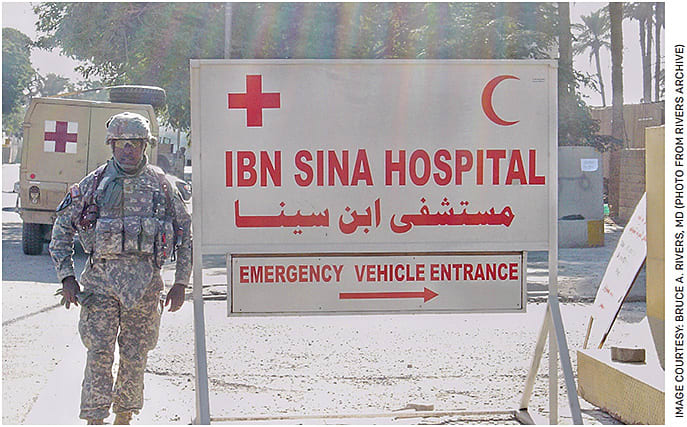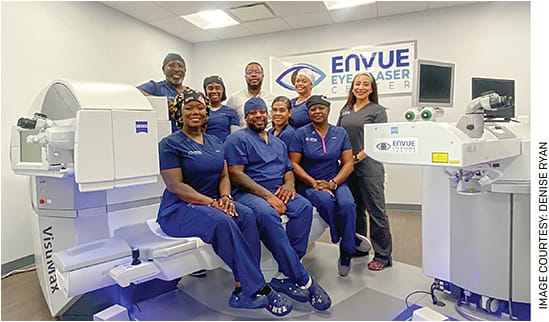The Army does a wonderful job of exposing you to a lot of different ophthalmology areas of interest, especially refractive surgery. When I completed my residency, I moved to Fort Stewart, Ga., where I became the chief of the ophthalmology clinic, which included a Warfighter Refractive Eye Surgery Program (WRESP) laser center. The military invested in the WRESP as a readiness and warfighter enhancement program, opening opportunities for service members previously ineligible for jobs due to their need for corrective lenses.
After leaving Fort Stewart, I became the director of the WRESP and Research Center at Fort Belvoir. As the Army’s primary laser research center, I was able to delve into research opportunities such as leading the Department of Defense in a preliminary investigation of small incision lenticule extraction (SMILE), cross-linking and functional performance studies.
A few years prior to my retirement from 30 years in the military, I started thinking about what I wanted to do next. The military ingrained certain behaviors of organization, so I relied on what I had been doing for years as an “operational order.”
A military operational order consists of five paragraphs: Situation, Mission, Execution, Service and Support, and Command and Control. In this article, I will discuss how applying this directive allowed me to establish my own practice, Envue Eye and Laser Center in Oxon Hill, Md., in 2021.
SITUATION
The DC metro area is a saturated vision-correction market, but I love the area and the people that I work with, and this was a chance for my family to finally drop roots after traveling many years for my military career. I initially planned to partner with a university, but I felt that I would be transferring into a bureaucracy that may come with large institutions. For this to work the way I envisioned, I needed to be in control.
After a market analysis, Oxon Hill lacked access to ophthalmic surgical care, so I decided to make the most of my situation. While there are vision correction practices situated mere miles away in Alexandria, for some, it can be a bridge too far. The unique locale of the National Harbor and being on the other side of the Potomac River in Maryland was an opportunity.
MISSION
My mission: Build and develop an ophthalmology practice that provides a premier patient experience and personalized medical care for anyone interested in vision correction, including laser vision correction (SMILE, LASIK, PRK), implantable collamer lenses, refractive lens exchange, and all ranges of cataract surgery in one convenient location. These were the same services I provided in the military, but this would be in a location devoid of these options.
EXECUTION
1. Expand professional network
I knew that ophthalmology in the civilian world would present new challenges and opportunities that I did not experience in the military. So, I reached out to a few colleagues — Drs. Sonny Goel (Goel Vision), Matt Hammond (Carrot Eye) and Courtney Crawford (Star Retina) — for advice. Connecting with and building relationships with these ophthalmologists has been a crucial part of my journey to establishing my own practice.
There are also many resources available to ophthalmologists now, including Ophthalmology Management, Solo Eye Docs Group blog, the Refractive Surgery Alliance, OphthoBizMinute and ASCRS (to name a few), as well as industry collaborators with a shared interest in bringing the best to patient care.
2. Identify and locate funding resources
Drawing from my years as a naval logistician aboard the USS Theodore Roosevelt, I knew I needed to find funding to start a solo practice. This proved to be more difficult than I thought. Although I was a leader in refractive surgery in the military, I was still an unproven commodity in the civilian world. I used LivePlan business planning software to develop my business plan — looking at my Strengths, Weaknesses, Opportunities and Threats, or SWOT:
- Strength. My military experience, including years of successfully running two ophthalmology surgery centers and managing budgets in excess of $1 million. Another “S” was the fact that very few people were offering SMILE in the DC Metro area.
- Weaknesses. New to the private practice landscape; extremely competitive market; no proven history from the bank’s perspective.
- Opportunities. The location — there were no ophthalmologists in the areas I was considering. Another “O” was my ability to offer SMILE at a time when laser vision correction was experiencing a surge.
- Threat. COVID-19, which proved to be a much bigger threat than I anticipated.
While I had a vision of what I wanted to build, it was important to share the plan and my story in a meaningful way to garner funding. Being able to visualize your plan for investors and funding sources with fine detail on who, what, when, where and how is critical to obtaining loans. Market analysis, construction, equipment, personnel, supplies, marketing and projections of gains and losses are primary concerns to address as part of your plan. LivePlan helped coordinate these considerations to present my plan to potential investors.

Dr. Rivers on deployment in Iraq as the brigade surgeon.
3. Identify a location in need
I really hoped “If you build it, they will come” was true. There wasn’t any practice offering all the cataract and refractive surgery options we planned on offering. So, although there were optometry and ophthalmology practices not far from the location we were considering, none of them were offering the range of services we planned on offering. While I was fortunate to find space in an older multi-purpose building, in retrospect, given COVID-19’s challenges, I would’ve negotiated a longer-term rent abatement.
4. Social media
I really wish I’d learned more about managing Envue’s social media presence from the outset. But I hesitated, wanting to get the construction finished before I began marketing my practice. In retrospect, I could have worked on content and tried to generate more buzz about what was coming.
Despite having a website, I did not understand search engine optimization (SEO) and the need to have our online presence built up long before we’d open. Google algorithms require time to build and the only way to do so is to get visitors to your site. Blog posts, photos, tours and construction updates would’ve all been good content to get traffic on our website and Google business page. Additionally, I would have spent more time earlier working on our SEO by tailoring my content posts. There are numerous guides and videos that show you how to identify the most valuable keywords for your business and how to use these keywords to rank higher on search engines.
Lastly, I learned to manage different social media using Hootsuite, which allows me to schedule posts across social networks. Our social media is a mix of impromptu content (office videos we make on any given day) and planned, curated content using apps like Canva.
5. Permitting
Being in the military, I should have seen this one coming: You need permission for almost everything. However, COVID-19-related changes to the permitting process resulted in not being able to hire a permit-expediter, thereby stalling construction. This, combined with supply issues, led to an almost 6-month delay in getting construction started.
6. Keeping skills sharp
To keep my surgical skills sharp, I tapped into my network and started volunteering at a Veteran’s hospital performing cataract surgery. Doing so made me realize the access to care issues facing too many veterans. I updated my mission to include providing care to veterans at no out-of-pocket expense to the veteran. Half of my staff are prior military service, so this is personal.
7. Partnerships
I never had to worry about the billing or payer side of things in the military, so this was a blind spot. Finding a trusted partner who can help you get mobilized sooner is critical to success in the long run. For example, we turned to iOR Partners to get us off the ground and running on the office-based surgery side. iOR Partners facilitated the equipment, supplies, documentation, staff training and billing for our surgical practice. While my staff was trained in the OR, we had no experience in verifying insurance benefits, coding, or billing for surgery. iOR got us up and running earlier and more efficiently.
SERVICE AND SUPPORT
1. Staff
I once again fell back on my training, relying on what makes an A-team: an amazing staff. My staff made me feel like this was going to be a great OR day, knew all my comprehensive patients by name, stopped me and asked if I wanted to re-refract a patient because they knew the patient needed reassurance.
The best way I know how to serve patients is to bring in the best team I could find. The place to start was to look at the people who worked well with me in the past, who were sticklers for detail, shared the same belief in patient care and customer service and were familiar with the procedures we planned to offer.
Given that I started my career as an eye tech in the military, I always look for those eager to learn and share their knowledge. I also look for those with hard and soft skills. Our staff excel in their job specialty, and we have an incredible array of other talents as well.
2. Payroll
Starting off a practice, payroll is your second largest expense after rent, so we’re a lean crew that’s multi-faceted. Technology played a large part in helping to streamline our patient flow, thereby allowing us to do more with fewer people. As part of selecting staff, I learned to make sure job descriptions include the level of overlap and multitasking needed. These are listed as additional duties, so when we have clinic training, it’s all-encompassing. Educating staff is critical in this regard, as every staff member should be able to describe the patient experience in detail, including the patient interface with the website, in-office reception, clinical evaluation, and exploration of vision goals. This leads to a seamless experience for patients and staff.
Asking all this from staff also means making sure you are compensating them for it. Invest in your staff, as they are investing in you.

The team at Envue Eye & Laser Center
3. Technology
Our practice is all digital, so having all our equipment interconnected decreases human error and improves patient flow. For example, having an EHR that talks to imaging devices in real-time prevents the need for additional printing and scanning, which improves efficiency. Daily workflow transfers to all machines, reducing data entry time delays and errors.
By the time I see a patient, I already have access to all their clinical workup and imaging, so I can educate patients on their condition and my recommendations.
COMMAND AND CONTROL
You cannot be everywhere all the time. I was fortunate to develop a partnership with Denise Ryan, the deputy director for research at my last military duty station. Our synergy has enabled me to focus on patient care while Denise, as the COO, manages the day-to-day operations. Our partnership balances the yin and yang of our practice. While we are different in many ways, Denise and I share trust, values and vision. Our complementary skills work well serially or in parallel, depending on the task.
CONCLUSION
My military career prepared me for many challenges, though perhaps not to the extent of opening a new practice during a global pandemic. However, approaching this endeavor like a military mission has given me the structure and discipline to push through these challenges. Although many would say this is my second career after leaving the military, with Envue Eye and Laser Center I’m just getting started. OM









